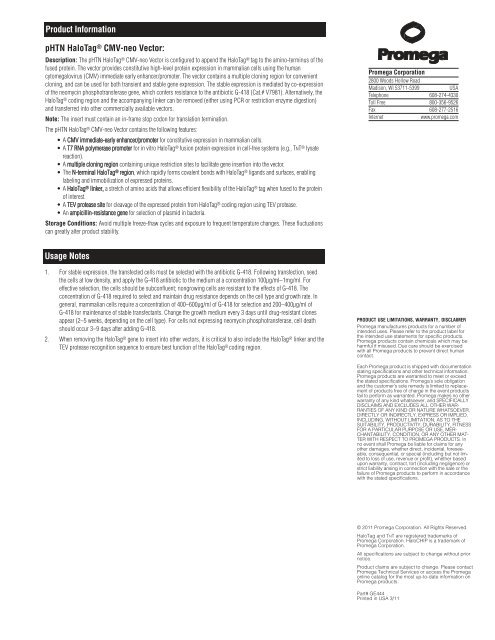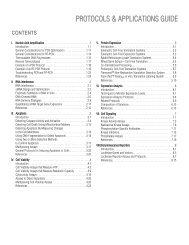You also want an ePaper? Increase the reach of your titles
YUMPU automatically turns print PDFs into web optimized ePapers that Google loves.
Product Information<br />
pHTN <strong>HaloTag</strong> ® CMV-neo Vector:<br />
Description: The pHTN <strong>HaloTag</strong> ® CMV-neo Vector is configured to append the <strong>HaloTag</strong> ® tag to the amino-terminus of the<br />
fused protein. The vector provides constitutive high-level protein expression in mammalian cells using the human<br />
cytomegalovirus (CMV) immediate early enhancer/promoter. The vector contains a multiple cloning region for convenient<br />
cloning, and can be used for both transient and stable gene expression. The stable expression is mediated by co-expression<br />
of the neomycin phosphotransferase gene, which confers resistance to the antibiotic G-418 (Cat.# V7981). Alternatively, the<br />
<strong>HaloTag</strong> ® coding region and the accompanying linker can be removed (either using PCR or restriction enzyme digestion)<br />
and transferred into other commercially available vectors.<br />
Note: The insert must contain an in-frame stop codon for translation termination.<br />
The pHTN <strong>HaloTag</strong> ® CMV-neo Vector contains the following features:<br />
A CMV immediate-early enhancer/promoter for constitutive expression in mammalian cells.<br />
A T7 RNA polymerase promoter for in vitro <strong>HaloTag</strong> ® fusion protein expression in cell-free systems (e.g., TNT ® lysate<br />
reaction).<br />
A multiple cloning region containing unique restriction sites to facilitate gene insertion into the vector.<br />
The N-<strong>terminal</strong> <strong>HaloTag</strong> ® region, which rapidly forms covalent bonds with <strong>HaloTag</strong> ® ligands and surfaces, enabling<br />
labeling and immobilization of expressed proteins.<br />
A <strong>HaloTag</strong> ® linker, a stretch of amino acids that allows efficient flexibility of the <strong>HaloTag</strong> ® tag when fused to the protein<br />
of interest.<br />
A TEV protease site for cleavage of the expressed protein from <strong>HaloTag</strong> ® coding region using TEV protease.<br />
An ampicillin-resistance gene for selection of plasmid in bacteria.<br />
Storage Conditions: Avoid multiple freeze-thaw cycles and exposure to frequent temperature changes. These fluctuations<br />
can greatly alter product stability.<br />
Usage Notes<br />
1. For stable expression, the transfected cells must be selected with the antibiotic G-418. Following transfection, seed<br />
the cells at low density, and apply the G-418 antibiotic to the medium at a concentration 100µg/ml–1mg/ml. For<br />
effective selection, the cells should be subconfluent; nongrowing cells are resistant to the effects of G-418. The<br />
concentration of G-418 required to select and maintain drug resistance depends on the cell type and growth rate. In<br />
general, mammalian cells require a concentration of 400–600µg/ml of G-418 for selection and 200–400µg/ml of<br />
G-418 for maintenance of stable transfectants. Change the growth medium every 3 days until drug-resistant clones<br />
appear (2–5 weeks, depending on the cell type). For cells not expressing neomycin phosphotransferase, cell death<br />
should occur 3–9 days after adding G-418.<br />
2. When removing the <strong>HaloTag</strong> ® gene to insert into other vectors, it is critical to also include the <strong>HaloTag</strong> ® linker and the<br />
TEV protease recognition sequence to ensure best function of the <strong>HaloTag</strong> ® coding region.<br />
<strong>Promega</strong> Corporation<br />
2800 Woods Hollow Road<br />
Madison, WI 53711-5399 USA<br />
Telephone 608-274-4330<br />
Toll Free 800-356-9526<br />
Fax 608-277-2516<br />
Internet www.promega.com<br />
PRODUCT USE LIMITATIONS, WARRANTY, DISCLAIMER<br />
<strong>Promega</strong> manufactures products for a number of<br />
intended uses. Please refer to the product label for<br />
the intended use statements for specific products.<br />
<strong>Promega</strong> products contain chemicals which may be<br />
harmful if misused. Due care should be exercised<br />
with all <strong>Promega</strong> products to prevent direct human<br />
contact.<br />
Each <strong>Promega</strong> product is shipped with documentation<br />
stating specifications and other technical information.<br />
<strong>Promega</strong> products are warranted to meet or exceed<br />
the stated specifications. <strong>Promega</strong>'s sole obligation<br />
and the customer's sole remedy is limited to replacement<br />
of products free of charge in the event products<br />
fail to perform as warranted. <strong>Promega</strong> makes no other<br />
warranty of any kind whatsoever, and SPECIFICALLY<br />
DISCLAIMS AND EXCLUDES ALL OTHER WAR-<br />
RANTIES OF ANY KIND OR NATURE WHATSOEVER,<br />
DIRECTLY OR INDIRECTLY, EXPRESS OR IMPLIED,<br />
INCLUDING, WITHOUT LIMITATION, AS TO THE<br />
SUITABILITY, PRODUCTIVITY, DURABILITY, FITNESS<br />
FOR A PARTICULAR PURPOSE OR USE, MER-<br />
CHANTABILITY, CONDITION, OR ANY OTHER MAT-<br />
TER WITH RESPECT TO PROMEGA PRODUCTS. In<br />
no event shall <strong>Promega</strong> be liable for claims for any<br />
other damages, whether direct, incidental, foreseeable,<br />
consequential, or special (including but not limited<br />
to loss of use, revenue or profit), whether based<br />
upon warranty, contract, tort (including negligence) or<br />
strict liability arising in connection with the sale or the<br />
failure of <strong>Promega</strong> products to perform in accordance<br />
with the stated specifications.<br />
© 2011 <strong>Promega</strong> Corporation. All Rights Reserved.<br />
<strong>HaloTag</strong> and TNT are registered trademarks of<br />
<strong>Promega</strong> Corporation. HaloCHIP is a trademark of<br />
<strong>Promega</strong> Corporation.<br />
All specifications are subject to change without prior<br />
notice.<br />
Product claims are subject to change. Please contact<br />
<strong>Promega</strong> Technical Services or access the <strong>Promega</strong><br />
online catalog for the most up-to-date information on<br />
<strong>Promega</strong> products.<br />
Part# GE444<br />
Printed in USA 3/11
pHTN <strong>HaloTag</strong> ® CMV-neo Vector Features and Circle Map<br />
The following features are present in the pHTN <strong>HaloTag</strong> ® CMV-neo Vector based on<br />
nucleotide sequence.<br />
CMV intermediate early enhancer/promoter 1–742<br />
Chimeric intron 857–989<br />
T7 RNA polymerase promoter (–17 to +3) 1033–1052<br />
<strong>HaloTag</strong> ® coding region 1067–1957<br />
<strong>HaloTag</strong> ® linker 1958–1996<br />
TEV protease recognition sequence 1970–1990<br />
Multiple cloning region 1997–2072<br />
SV40 late polyadenylation signal 2135–2356<br />
SV40 enhancer and early promoter 2455–2873<br />
SV40 minimum origin of replication 2771–2836<br />
Neomycin phophotransferase coding region 2918–3712<br />
Synthetic polyadenylation signal 3776–3824<br />
β-lactamase (Ampr ) coding region 4085–4945<br />
ColE1-derived plasmid origin of replication 5100–5136<br />
ori<br />
Amp r<br />
Synthetic poly(A)<br />
signal<br />
pHTN <strong>HaloTag</strong> ® CMV-neo<br />
Vector<br />
(6143bp)<br />
Neo r<br />
CMV Enhancer/<br />
Promoter<br />
intron<br />
SV40 Early<br />
Enhancer/<br />
Promoter<br />
T7<br />
SV40 Late<br />
poly(A)<br />
<strong>HaloTag</strong> ® Open<br />
Reading Frame<br />
TEV<br />
site<br />
SgfI<br />
PvuI<br />
EcoRI<br />
EcoICRI<br />
SacI<br />
SacII<br />
EcoRV<br />
XbaI<br />
PspOMI<br />
ApaI<br />
SbfI<br />
NotI<br />
Figure 1. pHTN <strong>HaloTag</strong> ® CMV-neo Vector circle map and sequence reference points.<br />
SgfI<br />
PvuI<br />
EcoRI<br />
EcoICRI<br />
SacI<br />
EcoRV<br />
SacII XbaI<br />
Usage Information<br />
2002<br />
2002<br />
2010<br />
2019<br />
2021<br />
2028<br />
2032<br />
2034<br />
2043<br />
2047<br />
2058<br />
2067<br />
5´– GCG ATC GCT TCC GAA TTC AGA GCT CAA CCG CGG ATA TCT AGA TTT<br />
A I A S E F R A Q P R I S R F<br />
PspOMI<br />
ApaI<br />
SbfI<br />
NotI<br />
GGG CCC AAT TCC TGC AGG ATT TTG CGG CCG C –3´<br />
G P N S C R I L R P<br />
Figure 2. pHTN <strong>HaloTag</strong> ® CMV-neo Vector multiple cloning region sequence and unique<br />
restriction sites. The amino acid sequence corresponds to the correct reading frame for the<br />
<strong>HaloTag</strong> ® coding region.<br />
9855MA<br />
I. Extraction Protocol for the <strong>HaloTag</strong> ® Vector Card<br />
Materials to be Supplied by User<br />
extraction buffer [10mM Tris (pH 8.0), 20mM NaCl]<br />
E. coli competent cells for transformation (see Section III for suggestions)<br />
1. Cut the vector card on the dotted lines and aseptically remove the filter paper square<br />
containing the dried <strong>HaloTag</strong> ® Vector DNA (see the QuickTime video for a<br />
demonstration at: www.halotag.com).<br />
2. Transfer the filter paper to a 1.5ml centrifuge tube (e.g., using sterile forceps).<br />
3. Add 30µl of extraction buffer, vortex and briefly centrifuge.<br />
4. Ensure that the filter paper is submerged in the buffer, and incubate for 30 minutes at<br />
room temperature. Vortex sample.<br />
5. Transform 2–10µl of the extracted vector DNA into competent cells, following<br />
manufacturer’s instructions for the competent cells. Store unused DNA at –20°C.<br />
6. Plate the cells on media with Ampr selection, dispensing 2–20% of the<br />
transformation reaction volume.<br />
Note: We recommend working with each vector (N-<strong>terminal</strong> and C-<strong>terminal</strong>)<br />
separately to minimize the risk of cross-contamination.<br />
II. Troubleshooting<br />
Symptoms Solutions<br />
Poor transformation Check the competent cells. If necessary, make or purchase<br />
fresh cells.<br />
Check for proper antibiotic selection. Use ampicillin or<br />
carbenicillin to select for the Ampr vector.<br />
Plate a larger volume of the transformation reaction;<br />
if necessary, pellet the transformed cells and resuspend in<br />
100µl of medium. Plate all of the transformed cells.<br />
Dry down the volume of extracted DNA to 5µl and transform.<br />
Note about electroporation<br />
The extraction buffer contains 20mM NaCl, which may be incompatible with<br />
electroporation. Before proceeding with electroporation, ethanol precipitate the vector<br />
DNA from the extraction buffer and resuspend in buffer without salt.<br />
III. Related Products<br />
Product Size Cat.#<br />
JM109 Competent Cells, >10 8cfu/µg 5 × 200µl L2001<br />
JM109 Competent Cells, >10 7 cfu/µg 5 × 200µl L1001<br />
HB101 Competent Cells, >10 8cfu/µg 5 × 200µl L2011<br />
<strong>HaloTag</strong> ® Mammalian Protein Detection and<br />
Purification System 1 each G6795<br />
<strong>HaloTag</strong> ® Mammalian Pull-Down and Labeling System 24 reactions G6500<br />
HaloCHIP System 20 reactions G9410<br />
Part# GE444<br />
Printed in USA 3/11<br />
<strong>Promega</strong> Corporation · 2800 Woods Hollow Road·Madison, WI 53711-5399 U.S.A. · Toll Free in the USA 800-356-9526 · Telephone 608-274-4330 · www.promega.com<br />
9853MA

















